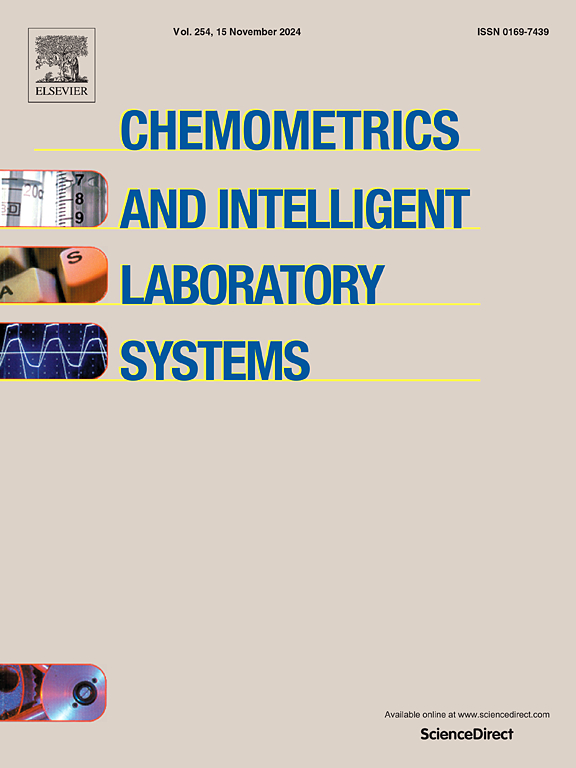An unsupervised domain adaptation regression method in kernel partial least squares subspace embedded with joint statistical and manifold alignment for Fourier-transform infrared spectroscopy in agri-food analysis
IF 3.8
2区 化学
Q2 AUTOMATION & CONTROL SYSTEMS
Chemometrics and Intelligent Laboratory Systems
Pub Date : 2025-05-23
DOI:10.1016/j.chemolab.2025.105442
引用次数: 0
Abstract
Within the agri-food sector, the precise measurement of essential ingredients in samples across different measurement contexts using Fourier Transform Infrared spectroscopy (FTIR) is crucial, underscoring the need for advanced calibration methods with extensive generalizability. Domain adaptation (DA) in machine learning is a pivotal area of research focused on training models to be adaptable to both source and target domains with differing data distributions. This paper delves into the application of unsupervised domain adaptation (UDA) for FTIR analysis in agri-food products, utilizing unlabeled data from the target domain to address the challenge of limited reference samples. To realize complex nonlinear adaptation, combining the advantages of statistical alignment and nonlinear ability from domain-invariant iterative partial least squares (DIPALS) and kernel domain adaptive partial least squares (da-PLS) respectively, a novel UDA regression method in kernel partial least squares subspace embedded with joint statistical and manifold alignment (JSMKPLS) is present by further integrating a manifold alignment strategy that could incorporate geometric nonlinear structure into the adaptation process. The framework simultaneously exploits the statistical and geometrical properties in reproducing kernel Hilbert space (RKHS) and extract the domain invariant features. Experimental results of corn, rice, γ-PGA fermentation and wheat datasets confirm the effectiveness of JSMKPLS for FTIR analysis.
农业食品分析中傅里叶变换红外光谱的联合统计和流形对准核偏最小二乘子空间无监督自适应回归方法
在农业食品领域,使用傅里叶变换红外光谱(FTIR)在不同测量环境下精确测量样品中的基本成分至关重要,这强调了对具有广泛通用性的先进校准方法的需求。领域自适应(DA)是机器学习中的一个关键研究领域,其重点是训练模型适应不同数据分布的源域和目标域。本文深入研究了无监督域自适应(UDA)在农产品FTIR分析中的应用,利用目标域的未标记数据来解决参考样本有限的挑战。为了实现复杂非线性自适应,分别结合域不变迭代偏最小二乘(DIPALS)和核域自适应偏最小二乘(da-PLS)的统计对齐和非线性能力的优点,在此基础上,进一步集成了一种将几何非线性结构融入自适应过程的流形对齐策略,提出了一种基于统计和流形对齐的核偏最小二乘子空间(JSMKPLS)的UDA回归方法。该框架同时利用核希尔伯特空间(RKHS)再现的统计和几何性质,提取域不变特征。玉米、水稻、γ-PGA发酵和小麦数据集的实验结果证实了JSMKPLS用于FTIR分析的有效性。
本文章由计算机程序翻译,如有差异,请以英文原文为准。
求助全文
约1分钟内获得全文
求助全文
来源期刊
CiteScore
7.50
自引率
7.70%
发文量
169
审稿时长
3.4 months
期刊介绍:
Chemometrics and Intelligent Laboratory Systems publishes original research papers, short communications, reviews, tutorials and Original Software Publications reporting on development of novel statistical, mathematical, or computer techniques in Chemistry and related disciplines.
Chemometrics is the chemical discipline that uses mathematical and statistical methods to design or select optimal procedures and experiments, and to provide maximum chemical information by analysing chemical data.
The journal deals with the following topics:
1) Development of new statistical, mathematical and chemometrical methods for Chemistry and related fields (Environmental Chemistry, Biochemistry, Toxicology, System Biology, -Omics, etc.)
2) Novel applications of chemometrics to all branches of Chemistry and related fields (typical domains of interest are: process data analysis, experimental design, data mining, signal processing, supervised modelling, decision making, robust statistics, mixture analysis, multivariate calibration etc.) Routine applications of established chemometrical techniques will not be considered.
3) Development of new software that provides novel tools or truly advances the use of chemometrical methods.
4) Well characterized data sets to test performance for the new methods and software.
The journal complies with International Committee of Medical Journal Editors'' Uniform requirements for manuscripts.

 求助内容:
求助内容: 应助结果提醒方式:
应助结果提醒方式:


